Strategic Management Literature Review: Obstacles & Mitigation
VerifiedAdded on 2023/06/07
|21
|5824
|314
Literature Review
AI Summary
This literature review examines strategic management within the construction industry, focusing on key challenges and potential mitigation strategies. It covers safety and hazard issues, emphasizing the importance of safety measures, training, and a strong safety culture. The review also explores technological competencies, highlighting the role of Building Information Modelling (BIM) and Competitive Intelligence (CI) in enhancing project efficiency and decision-making. Furthermore, it addresses organizational structuring and restructuring, along with the critical role of effective communication in project success. The review concludes by underscoring the need for construction companies to prioritize these factors to ensure successful project outcomes and maintain a competitive edge in the global market. Desklib provides this assignment as well as a wealth of study resources, including past papers and solved assignments, to support students in their academic endeavors.
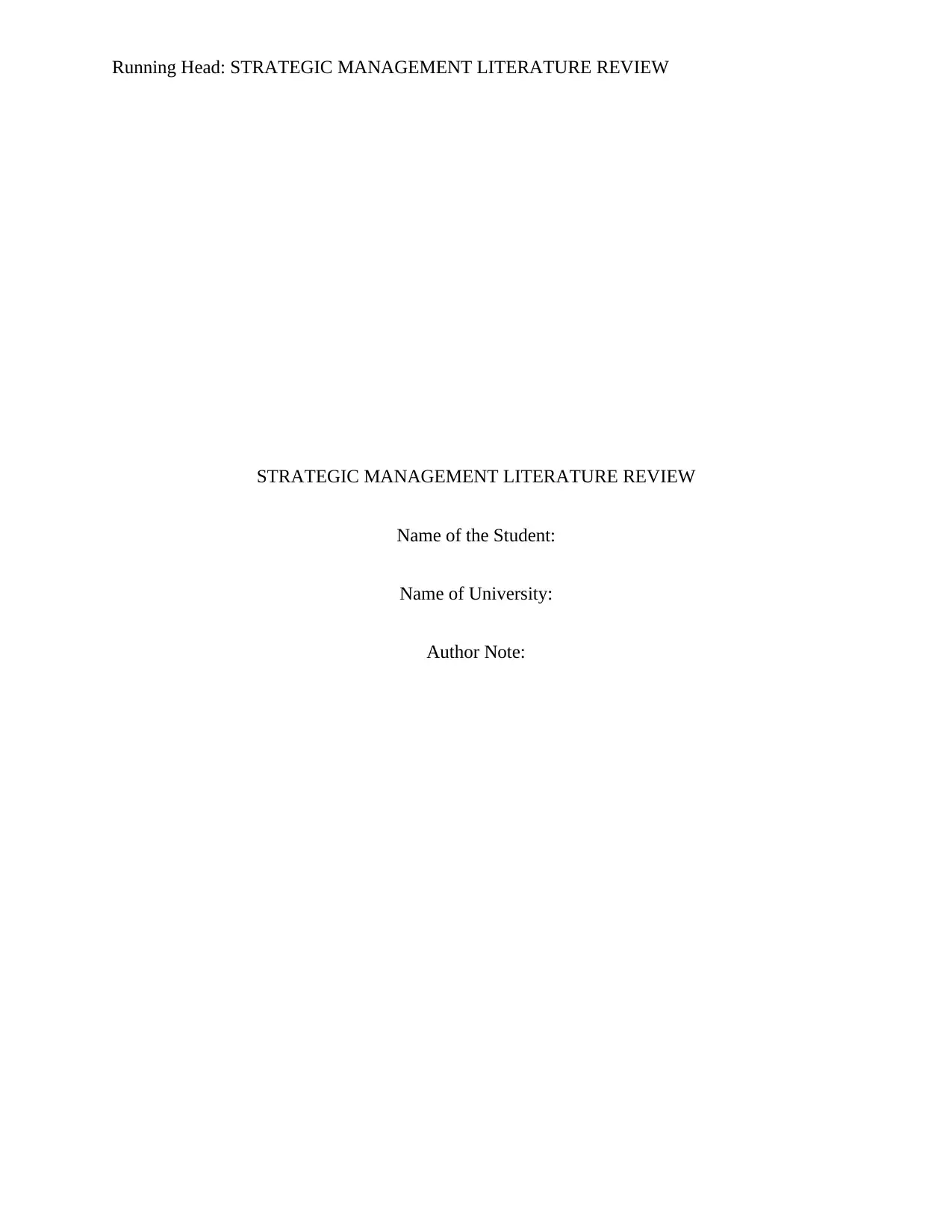
Running Head: STRATEGIC MANAGEMENT LITERATURE REVIEW
STRATEGIC MANAGEMENT LITERATURE REVIEW
Name of the Student:
Name of University:
Author Note:
STRATEGIC MANAGEMENT LITERATURE REVIEW
Name of the Student:
Name of University:
Author Note:
Paraphrase This Document
Need a fresh take? Get an instant paraphrase of this document with our AI Paraphraser
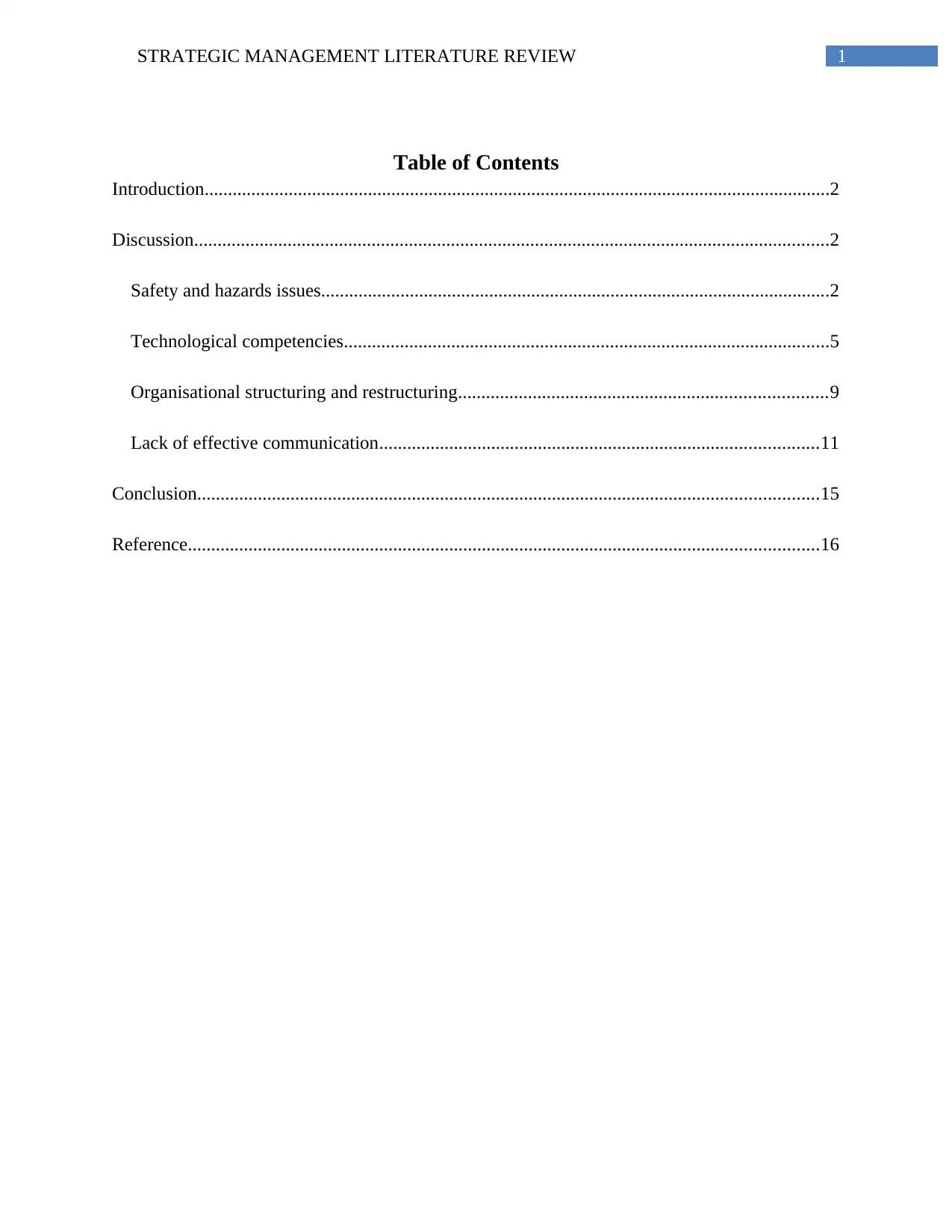
1STRATEGIC MANAGEMENT LITERATURE REVIEW
Table of Contents
Introduction......................................................................................................................................2
Discussion........................................................................................................................................2
Safety and hazards issues.............................................................................................................2
Technological competencies........................................................................................................5
Organisational structuring and restructuring...............................................................................9
Lack of effective communication..............................................................................................11
Conclusion.....................................................................................................................................15
Reference.......................................................................................................................................16
Table of Contents
Introduction......................................................................................................................................2
Discussion........................................................................................................................................2
Safety and hazards issues.............................................................................................................2
Technological competencies........................................................................................................5
Organisational structuring and restructuring...............................................................................9
Lack of effective communication..............................................................................................11
Conclusion.....................................................................................................................................15
Reference.......................................................................................................................................16
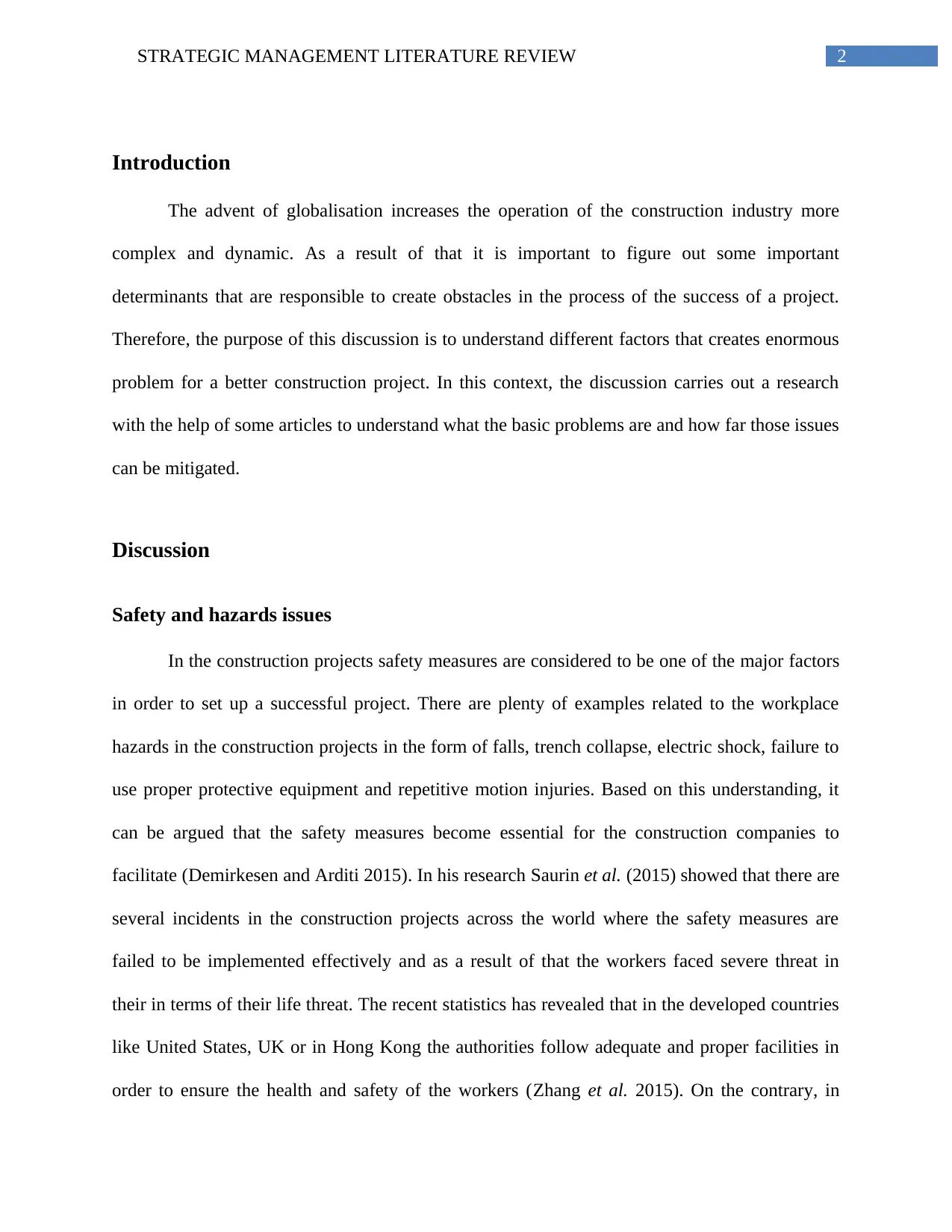
2STRATEGIC MANAGEMENT LITERATURE REVIEW
Introduction
The advent of globalisation increases the operation of the construction industry more
complex and dynamic. As a result of that it is important to figure out some important
determinants that are responsible to create obstacles in the process of the success of a project.
Therefore, the purpose of this discussion is to understand different factors that creates enormous
problem for a better construction project. In this context, the discussion carries out a research
with the help of some articles to understand what the basic problems are and how far those issues
can be mitigated.
Discussion
Safety and hazards issues
In the construction projects safety measures are considered to be one of the major factors
in order to set up a successful project. There are plenty of examples related to the workplace
hazards in the construction projects in the form of falls, trench collapse, electric shock, failure to
use proper protective equipment and repetitive motion injuries. Based on this understanding, it
can be argued that the safety measures become essential for the construction companies to
facilitate (Demirkesen and Arditi 2015). In his research Saurin et al. (2015) showed that there are
several incidents in the construction projects across the world where the safety measures are
failed to be implemented effectively and as a result of that the workers faced severe threat in
their in terms of their life threat. The recent statistics has revealed that in the developed countries
like United States, UK or in Hong Kong the authorities follow adequate and proper facilities in
order to ensure the health and safety of the workers (Zhang et al. 2015). On the contrary, in
Introduction
The advent of globalisation increases the operation of the construction industry more
complex and dynamic. As a result of that it is important to figure out some important
determinants that are responsible to create obstacles in the process of the success of a project.
Therefore, the purpose of this discussion is to understand different factors that creates enormous
problem for a better construction project. In this context, the discussion carries out a research
with the help of some articles to understand what the basic problems are and how far those issues
can be mitigated.
Discussion
Safety and hazards issues
In the construction projects safety measures are considered to be one of the major factors
in order to set up a successful project. There are plenty of examples related to the workplace
hazards in the construction projects in the form of falls, trench collapse, electric shock, failure to
use proper protective equipment and repetitive motion injuries. Based on this understanding, it
can be argued that the safety measures become essential for the construction companies to
facilitate (Demirkesen and Arditi 2015). In his research Saurin et al. (2015) showed that there are
several incidents in the construction projects across the world where the safety measures are
failed to be implemented effectively and as a result of that the workers faced severe threat in
their in terms of their life threat. The recent statistics has revealed that in the developed countries
like United States, UK or in Hong Kong the authorities follow adequate and proper facilities in
order to ensure the health and safety of the workers (Zhang et al. 2015). On the contrary, in
⊘ This is a preview!⊘
Do you want full access?
Subscribe today to unlock all pages.

Trusted by 1+ million students worldwide
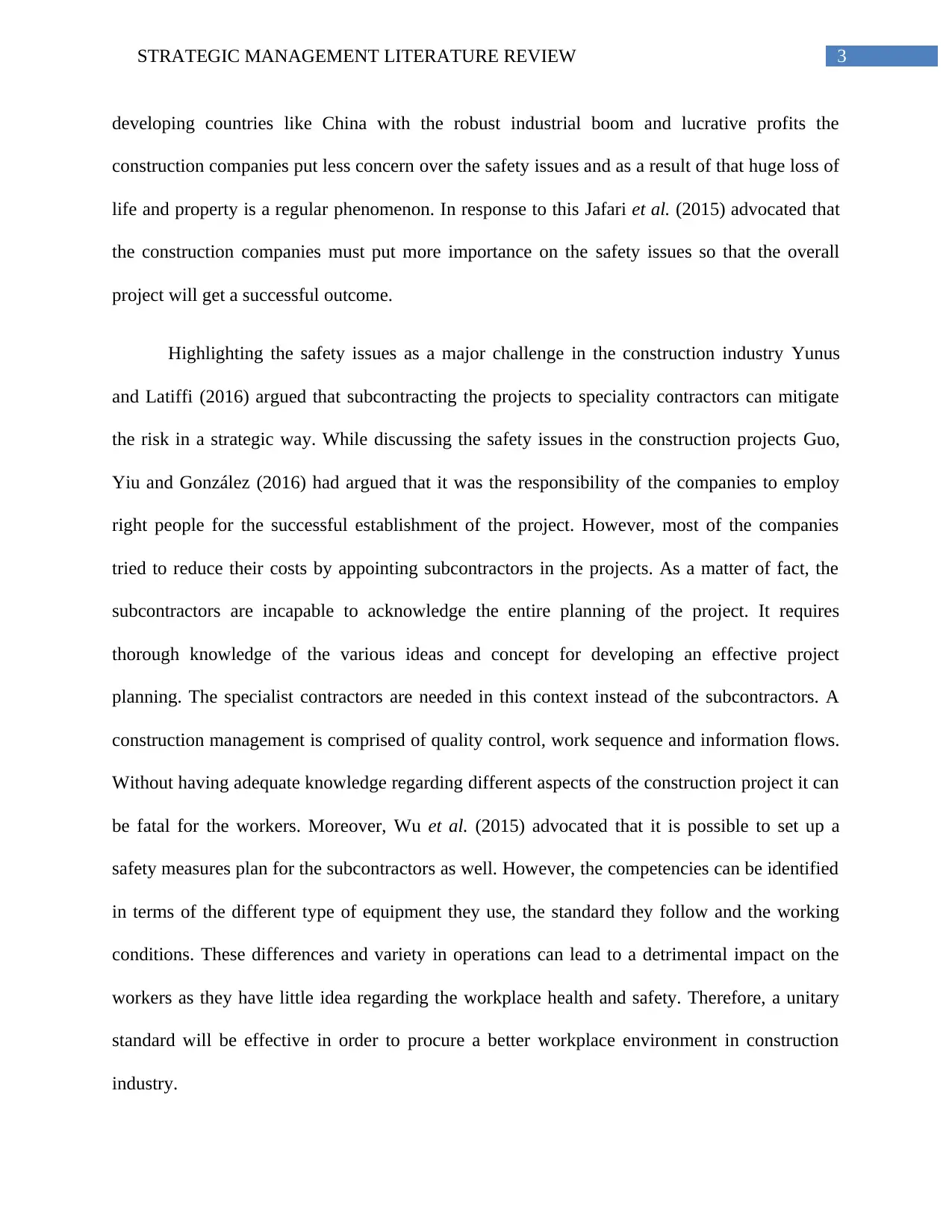
3STRATEGIC MANAGEMENT LITERATURE REVIEW
developing countries like China with the robust industrial boom and lucrative profits the
construction companies put less concern over the safety issues and as a result of that huge loss of
life and property is a regular phenomenon. In response to this Jafari et al. (2015) advocated that
the construction companies must put more importance on the safety issues so that the overall
project will get a successful outcome.
Highlighting the safety issues as a major challenge in the construction industry Yunus
and Latiffi (2016) argued that subcontracting the projects to speciality contractors can mitigate
the risk in a strategic way. While discussing the safety issues in the construction projects Guo,
Yiu and González (2016) had argued that it was the responsibility of the companies to employ
right people for the successful establishment of the project. However, most of the companies
tried to reduce their costs by appointing subcontractors in the projects. As a matter of fact, the
subcontractors are incapable to acknowledge the entire planning of the project. It requires
thorough knowledge of the various ideas and concept for developing an effective project
planning. The specialist contractors are needed in this context instead of the subcontractors. A
construction management is comprised of quality control, work sequence and information flows.
Without having adequate knowledge regarding different aspects of the construction project it can
be fatal for the workers. Moreover, Wu et al. (2015) advocated that it is possible to set up a
safety measures plan for the subcontractors as well. However, the competencies can be identified
in terms of the different type of equipment they use, the standard they follow and the working
conditions. These differences and variety in operations can lead to a detrimental impact on the
workers as they have little idea regarding the workplace health and safety. Therefore, a unitary
standard will be effective in order to procure a better workplace environment in construction
industry.
developing countries like China with the robust industrial boom and lucrative profits the
construction companies put less concern over the safety issues and as a result of that huge loss of
life and property is a regular phenomenon. In response to this Jafari et al. (2015) advocated that
the construction companies must put more importance on the safety issues so that the overall
project will get a successful outcome.
Highlighting the safety issues as a major challenge in the construction industry Yunus
and Latiffi (2016) argued that subcontracting the projects to speciality contractors can mitigate
the risk in a strategic way. While discussing the safety issues in the construction projects Guo,
Yiu and González (2016) had argued that it was the responsibility of the companies to employ
right people for the successful establishment of the project. However, most of the companies
tried to reduce their costs by appointing subcontractors in the projects. As a matter of fact, the
subcontractors are incapable to acknowledge the entire planning of the project. It requires
thorough knowledge of the various ideas and concept for developing an effective project
planning. The specialist contractors are needed in this context instead of the subcontractors. A
construction management is comprised of quality control, work sequence and information flows.
Without having adequate knowledge regarding different aspects of the construction project it can
be fatal for the workers. Moreover, Wu et al. (2015) advocated that it is possible to set up a
safety measures plan for the subcontractors as well. However, the competencies can be identified
in terms of the different type of equipment they use, the standard they follow and the working
conditions. These differences and variety in operations can lead to a detrimental impact on the
workers as they have little idea regarding the workplace health and safety. Therefore, a unitary
standard will be effective in order to procure a better workplace environment in construction
industry.
Paraphrase This Document
Need a fresh take? Get an instant paraphrase of this document with our AI Paraphraser
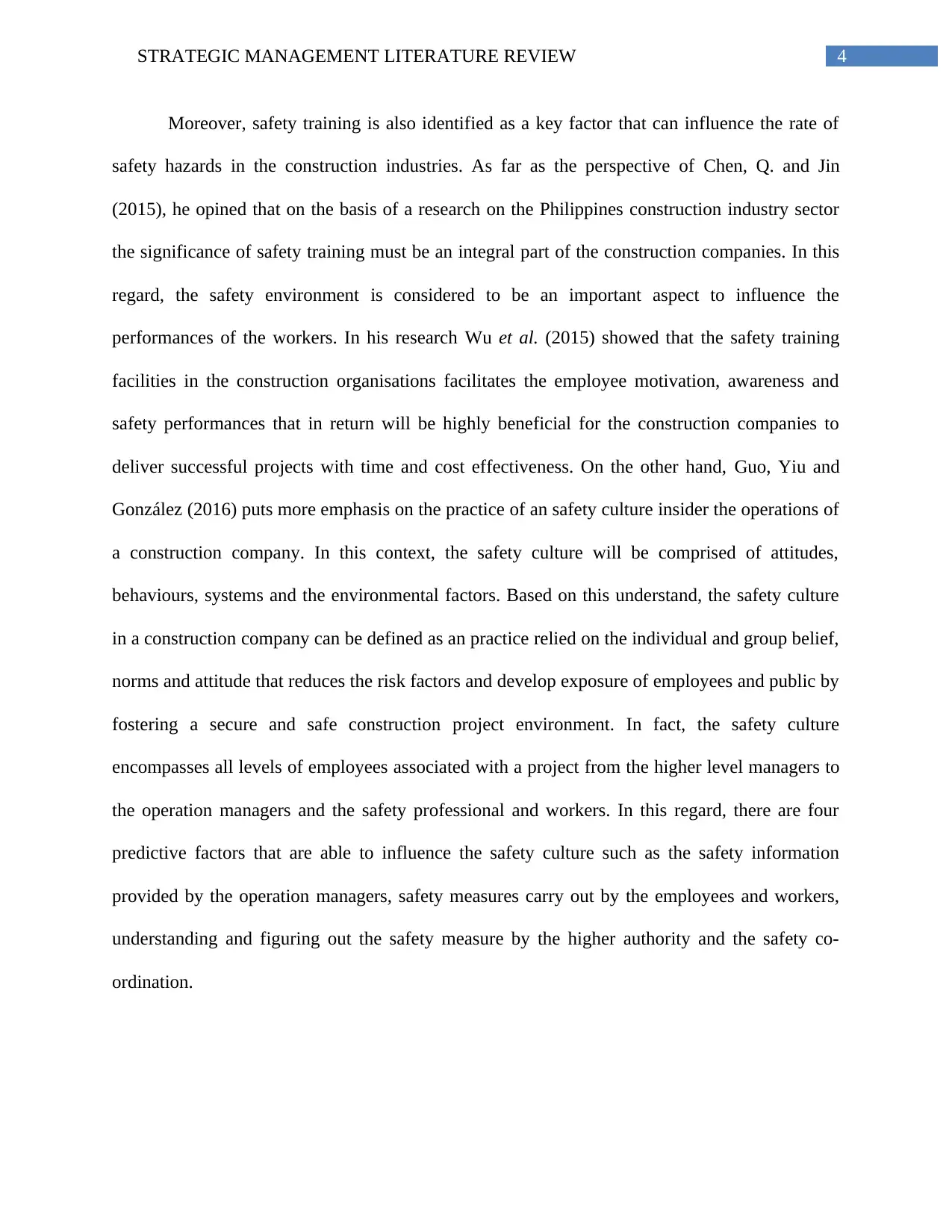
4STRATEGIC MANAGEMENT LITERATURE REVIEW
Moreover, safety training is also identified as a key factor that can influence the rate of
safety hazards in the construction industries. As far as the perspective of Chen, Q. and Jin
(2015), he opined that on the basis of a research on the Philippines construction industry sector
the significance of safety training must be an integral part of the construction companies. In this
regard, the safety environment is considered to be an important aspect to influence the
performances of the workers. In his research Wu et al. (2015) showed that the safety training
facilities in the construction organisations facilitates the employee motivation, awareness and
safety performances that in return will be highly beneficial for the construction companies to
deliver successful projects with time and cost effectiveness. On the other hand, Guo, Yiu and
González (2016) puts more emphasis on the practice of an safety culture insider the operations of
a construction company. In this context, the safety culture will be comprised of attitudes,
behaviours, systems and the environmental factors. Based on this understand, the safety culture
in a construction company can be defined as an practice relied on the individual and group belief,
norms and attitude that reduces the risk factors and develop exposure of employees and public by
fostering a secure and safe construction project environment. In fact, the safety culture
encompasses all levels of employees associated with a project from the higher level managers to
the operation managers and the safety professional and workers. In this regard, there are four
predictive factors that are able to influence the safety culture such as the safety information
provided by the operation managers, safety measures carry out by the employees and workers,
understanding and figuring out the safety measure by the higher authority and the safety co-
ordination.
Moreover, safety training is also identified as a key factor that can influence the rate of
safety hazards in the construction industries. As far as the perspective of Chen, Q. and Jin
(2015), he opined that on the basis of a research on the Philippines construction industry sector
the significance of safety training must be an integral part of the construction companies. In this
regard, the safety environment is considered to be an important aspect to influence the
performances of the workers. In his research Wu et al. (2015) showed that the safety training
facilities in the construction organisations facilitates the employee motivation, awareness and
safety performances that in return will be highly beneficial for the construction companies to
deliver successful projects with time and cost effectiveness. On the other hand, Guo, Yiu and
González (2016) puts more emphasis on the practice of an safety culture insider the operations of
a construction company. In this context, the safety culture will be comprised of attitudes,
behaviours, systems and the environmental factors. Based on this understand, the safety culture
in a construction company can be defined as an practice relied on the individual and group belief,
norms and attitude that reduces the risk factors and develop exposure of employees and public by
fostering a secure and safe construction project environment. In fact, the safety culture
encompasses all levels of employees associated with a project from the higher level managers to
the operation managers and the safety professional and workers. In this regard, there are four
predictive factors that are able to influence the safety culture such as the safety information
provided by the operation managers, safety measures carry out by the employees and workers,
understanding and figuring out the safety measure by the higher authority and the safety co-
ordination.
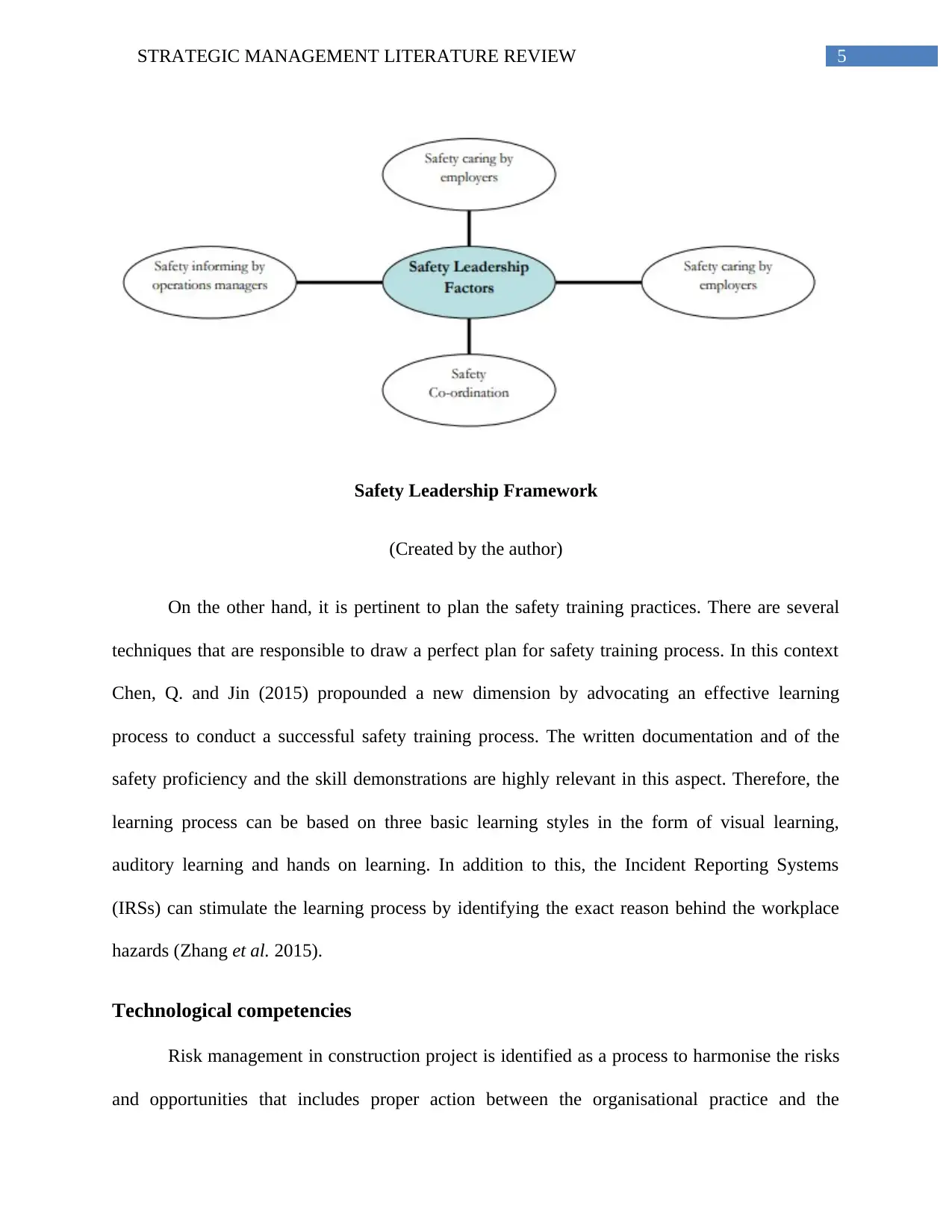
5STRATEGIC MANAGEMENT LITERATURE REVIEW
Safety Leadership Framework
(Created by the author)
On the other hand, it is pertinent to plan the safety training practices. There are several
techniques that are responsible to draw a perfect plan for safety training process. In this context
Chen, Q. and Jin (2015) propounded a new dimension by advocating an effective learning
process to conduct a successful safety training process. The written documentation and of the
safety proficiency and the skill demonstrations are highly relevant in this aspect. Therefore, the
learning process can be based on three basic learning styles in the form of visual learning,
auditory learning and hands on learning. In addition to this, the Incident Reporting Systems
(IRSs) can stimulate the learning process by identifying the exact reason behind the workplace
hazards (Zhang et al. 2015).
Technological competencies
Risk management in construction project is identified as a process to harmonise the risks
and opportunities that includes proper action between the organisational practice and the
Safety Leadership Framework
(Created by the author)
On the other hand, it is pertinent to plan the safety training practices. There are several
techniques that are responsible to draw a perfect plan for safety training process. In this context
Chen, Q. and Jin (2015) propounded a new dimension by advocating an effective learning
process to conduct a successful safety training process. The written documentation and of the
safety proficiency and the skill demonstrations are highly relevant in this aspect. Therefore, the
learning process can be based on three basic learning styles in the form of visual learning,
auditory learning and hands on learning. In addition to this, the Incident Reporting Systems
(IRSs) can stimulate the learning process by identifying the exact reason behind the workplace
hazards (Zhang et al. 2015).
Technological competencies
Risk management in construction project is identified as a process to harmonise the risks
and opportunities that includes proper action between the organisational practice and the
⊘ This is a preview!⊘
Do you want full access?
Subscribe today to unlock all pages.

Trusted by 1+ million students worldwide
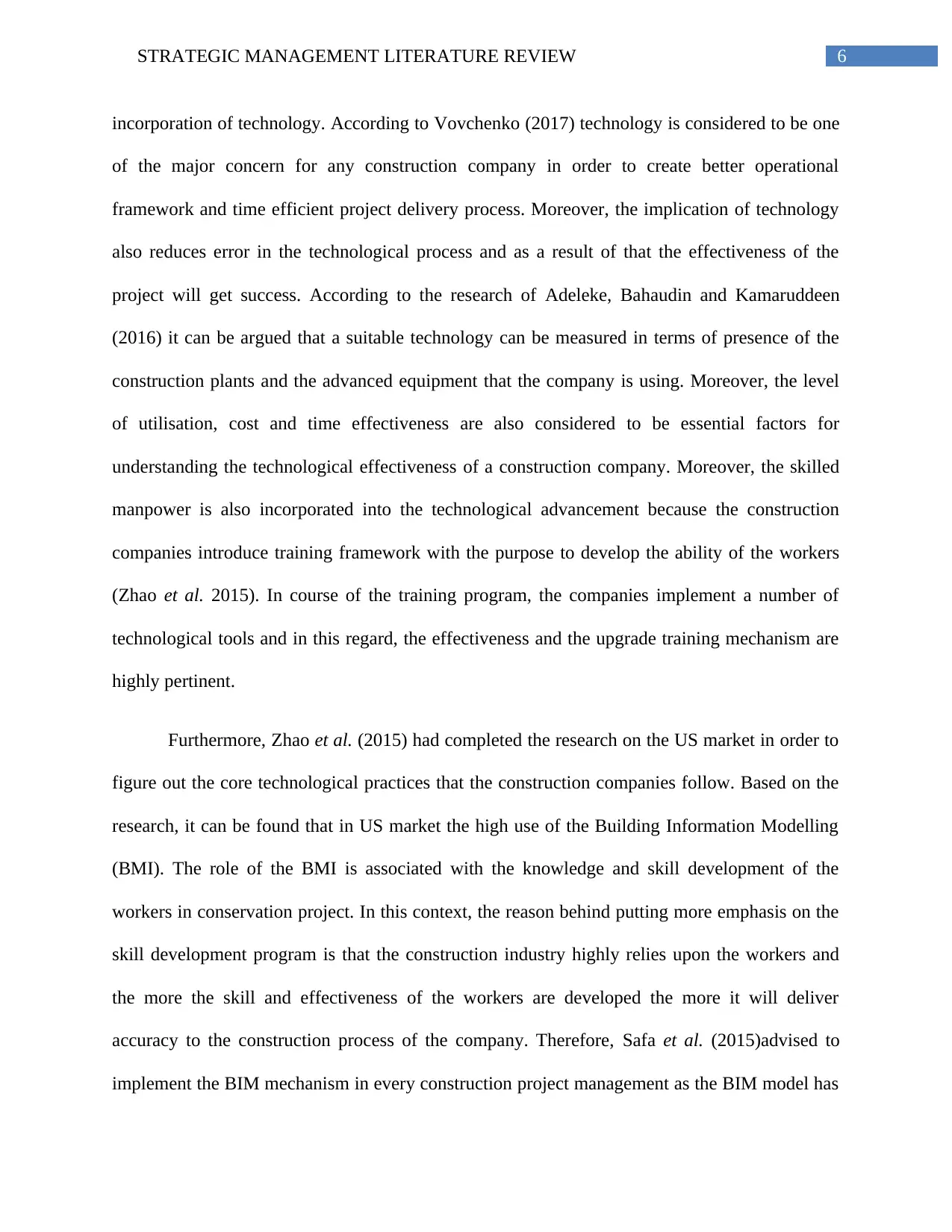
6STRATEGIC MANAGEMENT LITERATURE REVIEW
incorporation of technology. According to Vovchenko (2017) technology is considered to be one
of the major concern for any construction company in order to create better operational
framework and time efficient project delivery process. Moreover, the implication of technology
also reduces error in the technological process and as a result of that the effectiveness of the
project will get success. According to the research of Adeleke, Bahaudin and Kamaruddeen
(2016) it can be argued that a suitable technology can be measured in terms of presence of the
construction plants and the advanced equipment that the company is using. Moreover, the level
of utilisation, cost and time effectiveness are also considered to be essential factors for
understanding the technological effectiveness of a construction company. Moreover, the skilled
manpower is also incorporated into the technological advancement because the construction
companies introduce training framework with the purpose to develop the ability of the workers
(Zhao et al. 2015). In course of the training program, the companies implement a number of
technological tools and in this regard, the effectiveness and the upgrade training mechanism are
highly pertinent.
Furthermore, Zhao et al. (2015) had completed the research on the US market in order to
figure out the core technological practices that the construction companies follow. Based on the
research, it can be found that in US market the high use of the Building Information Modelling
(BMI). The role of the BMI is associated with the knowledge and skill development of the
workers in conservation project. In this context, the reason behind putting more emphasis on the
skill development program is that the construction industry highly relies upon the workers and
the more the skill and effectiveness of the workers are developed the more it will deliver
accuracy to the construction process of the company. Therefore, Safa et al. (2015)advised to
implement the BIM mechanism in every construction project management as the BIM model has
incorporation of technology. According to Vovchenko (2017) technology is considered to be one
of the major concern for any construction company in order to create better operational
framework and time efficient project delivery process. Moreover, the implication of technology
also reduces error in the technological process and as a result of that the effectiveness of the
project will get success. According to the research of Adeleke, Bahaudin and Kamaruddeen
(2016) it can be argued that a suitable technology can be measured in terms of presence of the
construction plants and the advanced equipment that the company is using. Moreover, the level
of utilisation, cost and time effectiveness are also considered to be essential factors for
understanding the technological effectiveness of a construction company. Moreover, the skilled
manpower is also incorporated into the technological advancement because the construction
companies introduce training framework with the purpose to develop the ability of the workers
(Zhao et al. 2015). In course of the training program, the companies implement a number of
technological tools and in this regard, the effectiveness and the upgrade training mechanism are
highly pertinent.
Furthermore, Zhao et al. (2015) had completed the research on the US market in order to
figure out the core technological practices that the construction companies follow. Based on the
research, it can be found that in US market the high use of the Building Information Modelling
(BMI). The role of the BMI is associated with the knowledge and skill development of the
workers in conservation project. In this context, the reason behind putting more emphasis on the
skill development program is that the construction industry highly relies upon the workers and
the more the skill and effectiveness of the workers are developed the more it will deliver
accuracy to the construction process of the company. Therefore, Safa et al. (2015)advised to
implement the BIM mechanism in every construction project management as the BIM model has
Paraphrase This Document
Need a fresh take? Get an instant paraphrase of this document with our AI Paraphraser
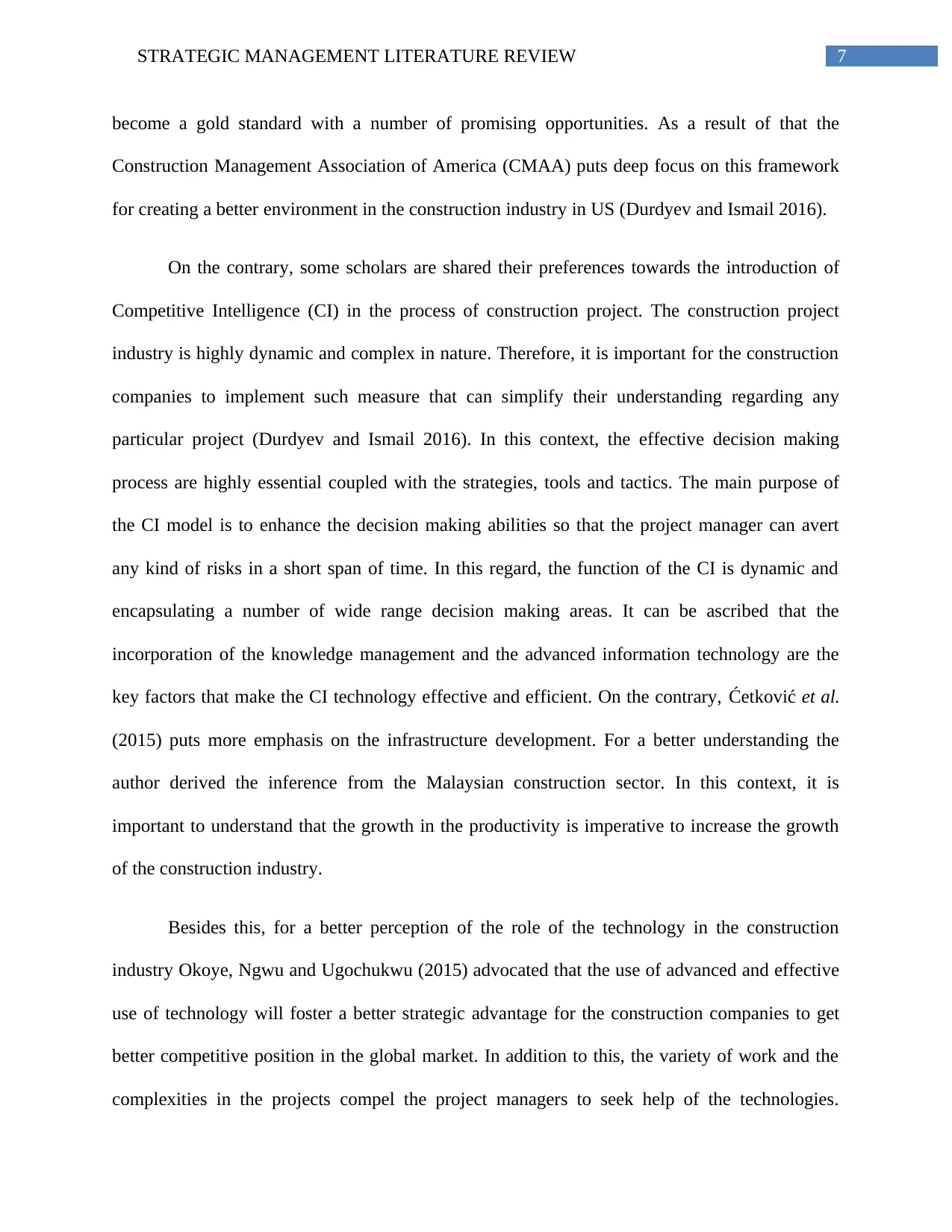
7STRATEGIC MANAGEMENT LITERATURE REVIEW
become a gold standard with a number of promising opportunities. As a result of that the
Construction Management Association of America (CMAA) puts deep focus on this framework
for creating a better environment in the construction industry in US (Durdyev and Ismail 2016).
On the contrary, some scholars are shared their preferences towards the introduction of
Competitive Intelligence (CI) in the process of construction project. The construction project
industry is highly dynamic and complex in nature. Therefore, it is important for the construction
companies to implement such measure that can simplify their understanding regarding any
particular project (Durdyev and Ismail 2016). In this context, the effective decision making
process are highly essential coupled with the strategies, tools and tactics. The main purpose of
the CI model is to enhance the decision making abilities so that the project manager can avert
any kind of risks in a short span of time. In this regard, the function of the CI is dynamic and
encapsulating a number of wide range decision making areas. It can be ascribed that the
incorporation of the knowledge management and the advanced information technology are the
key factors that make the CI technology effective and efficient. On the contrary, Ćetković et al.
(2015) puts more emphasis on the infrastructure development. For a better understanding the
author derived the inference from the Malaysian construction sector. In this context, it is
important to understand that the growth in the productivity is imperative to increase the growth
of the construction industry.
Besides this, for a better perception of the role of the technology in the construction
industry Okoye, Ngwu and Ugochukwu (2015) advocated that the use of advanced and effective
use of technology will foster a better strategic advantage for the construction companies to get
better competitive position in the global market. In addition to this, the variety of work and the
complexities in the projects compel the project managers to seek help of the technologies.
become a gold standard with a number of promising opportunities. As a result of that the
Construction Management Association of America (CMAA) puts deep focus on this framework
for creating a better environment in the construction industry in US (Durdyev and Ismail 2016).
On the contrary, some scholars are shared their preferences towards the introduction of
Competitive Intelligence (CI) in the process of construction project. The construction project
industry is highly dynamic and complex in nature. Therefore, it is important for the construction
companies to implement such measure that can simplify their understanding regarding any
particular project (Durdyev and Ismail 2016). In this context, the effective decision making
process are highly essential coupled with the strategies, tools and tactics. The main purpose of
the CI model is to enhance the decision making abilities so that the project manager can avert
any kind of risks in a short span of time. In this regard, the function of the CI is dynamic and
encapsulating a number of wide range decision making areas. It can be ascribed that the
incorporation of the knowledge management and the advanced information technology are the
key factors that make the CI technology effective and efficient. On the contrary, Ćetković et al.
(2015) puts more emphasis on the infrastructure development. For a better understanding the
author derived the inference from the Malaysian construction sector. In this context, it is
important to understand that the growth in the productivity is imperative to increase the growth
of the construction industry.
Besides this, for a better perception of the role of the technology in the construction
industry Okoye, Ngwu and Ugochukwu (2015) advocated that the use of advanced and effective
use of technology will foster a better strategic advantage for the construction companies to get
better competitive position in the global market. In addition to this, the variety of work and the
complexities in the projects compel the project managers to seek help of the technologies.
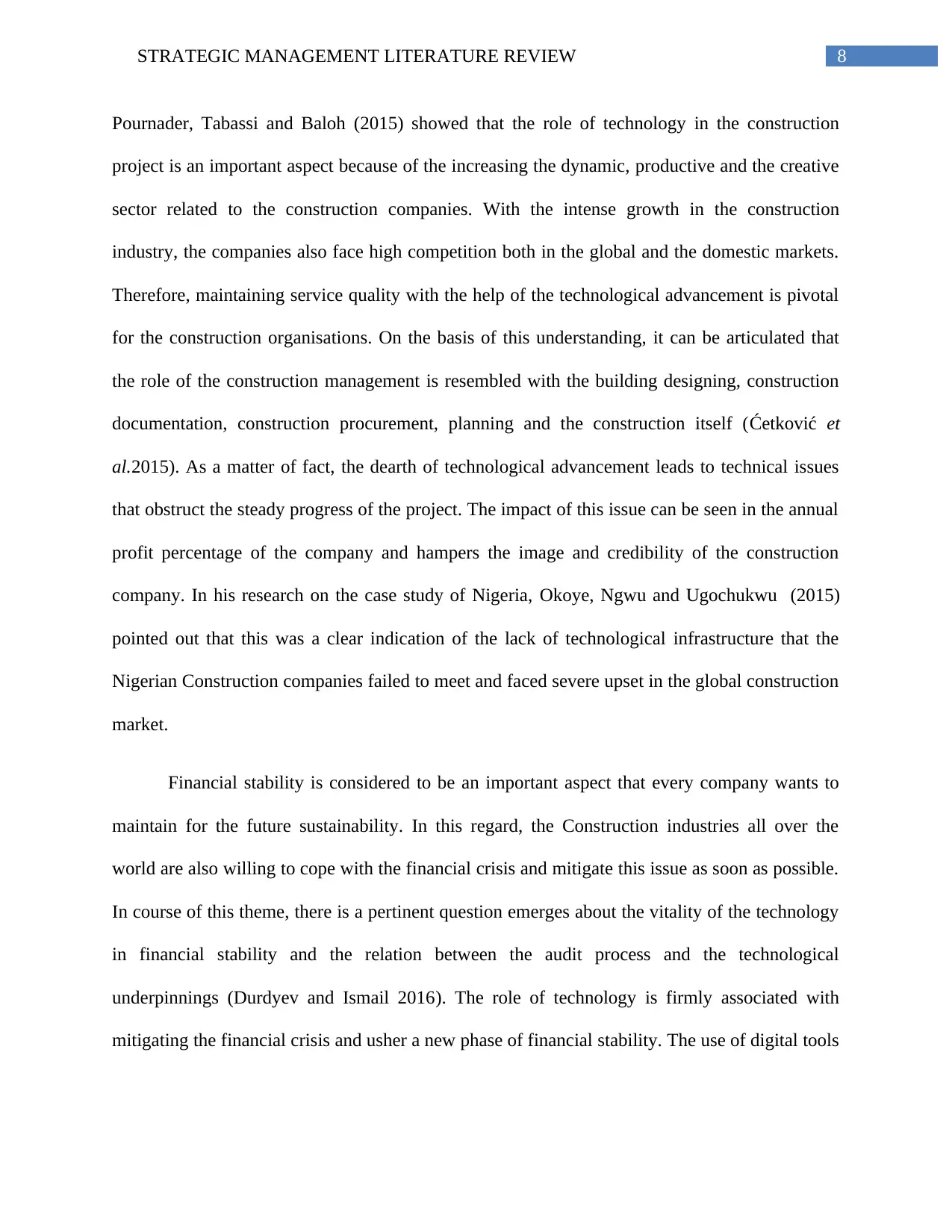
8STRATEGIC MANAGEMENT LITERATURE REVIEW
Pournader, Tabassi and Baloh (2015) showed that the role of technology in the construction
project is an important aspect because of the increasing the dynamic, productive and the creative
sector related to the construction companies. With the intense growth in the construction
industry, the companies also face high competition both in the global and the domestic markets.
Therefore, maintaining service quality with the help of the technological advancement is pivotal
for the construction organisations. On the basis of this understanding, it can be articulated that
the role of the construction management is resembled with the building designing, construction
documentation, construction procurement, planning and the construction itself (Ćetković et
al.2015). As a matter of fact, the dearth of technological advancement leads to technical issues
that obstruct the steady progress of the project. The impact of this issue can be seen in the annual
profit percentage of the company and hampers the image and credibility of the construction
company. In his research on the case study of Nigeria, Okoye, Ngwu and Ugochukwu (2015)
pointed out that this was a clear indication of the lack of technological infrastructure that the
Nigerian Construction companies failed to meet and faced severe upset in the global construction
market.
Financial stability is considered to be an important aspect that every company wants to
maintain for the future sustainability. In this regard, the Construction industries all over the
world are also willing to cope with the financial crisis and mitigate this issue as soon as possible.
In course of this theme, there is a pertinent question emerges about the vitality of the technology
in financial stability and the relation between the audit process and the technological
underpinnings (Durdyev and Ismail 2016). The role of technology is firmly associated with
mitigating the financial crisis and usher a new phase of financial stability. The use of digital tools
Pournader, Tabassi and Baloh (2015) showed that the role of technology in the construction
project is an important aspect because of the increasing the dynamic, productive and the creative
sector related to the construction companies. With the intense growth in the construction
industry, the companies also face high competition both in the global and the domestic markets.
Therefore, maintaining service quality with the help of the technological advancement is pivotal
for the construction organisations. On the basis of this understanding, it can be articulated that
the role of the construction management is resembled with the building designing, construction
documentation, construction procurement, planning and the construction itself (Ćetković et
al.2015). As a matter of fact, the dearth of technological advancement leads to technical issues
that obstruct the steady progress of the project. The impact of this issue can be seen in the annual
profit percentage of the company and hampers the image and credibility of the construction
company. In his research on the case study of Nigeria, Okoye, Ngwu and Ugochukwu (2015)
pointed out that this was a clear indication of the lack of technological infrastructure that the
Nigerian Construction companies failed to meet and faced severe upset in the global construction
market.
Financial stability is considered to be an important aspect that every company wants to
maintain for the future sustainability. In this regard, the Construction industries all over the
world are also willing to cope with the financial crisis and mitigate this issue as soon as possible.
In course of this theme, there is a pertinent question emerges about the vitality of the technology
in financial stability and the relation between the audit process and the technological
underpinnings (Durdyev and Ismail 2016). The role of technology is firmly associated with
mitigating the financial crisis and usher a new phase of financial stability. The use of digital tools
⊘ This is a preview!⊘
Do you want full access?
Subscribe today to unlock all pages.

Trusted by 1+ million students worldwide
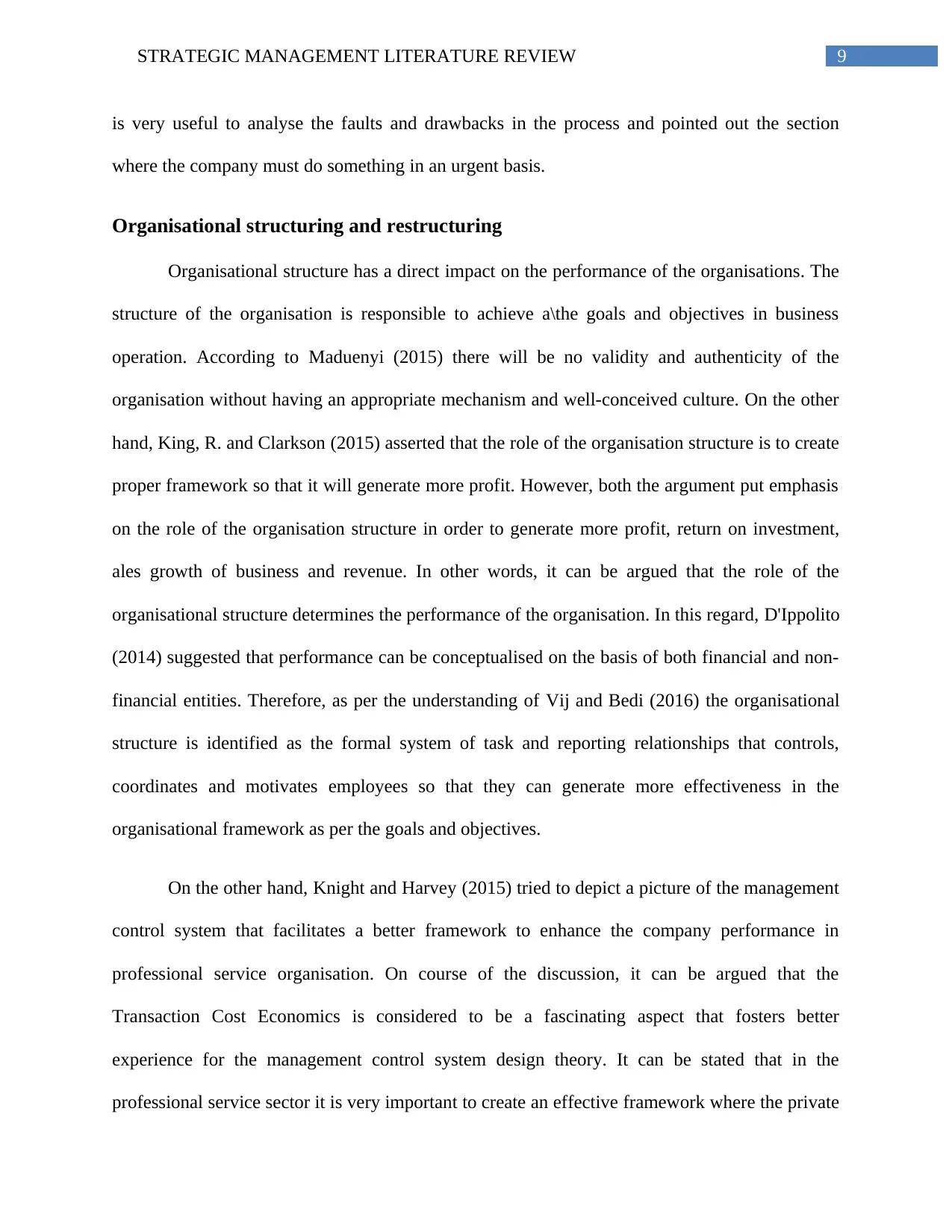
9STRATEGIC MANAGEMENT LITERATURE REVIEW
is very useful to analyse the faults and drawbacks in the process and pointed out the section
where the company must do something in an urgent basis.
Organisational structuring and restructuring
Organisational structure has a direct impact on the performance of the organisations. The
structure of the organisation is responsible to achieve a\the goals and objectives in business
operation. According to Maduenyi (2015) there will be no validity and authenticity of the
organisation without having an appropriate mechanism and well-conceived culture. On the other
hand, King, R. and Clarkson (2015) asserted that the role of the organisation structure is to create
proper framework so that it will generate more profit. However, both the argument put emphasis
on the role of the organisation structure in order to generate more profit, return on investment,
ales growth of business and revenue. In other words, it can be argued that the role of the
organisational structure determines the performance of the organisation. In this regard, D'Ippolito
(2014) suggested that performance can be conceptualised on the basis of both financial and non-
financial entities. Therefore, as per the understanding of Vij and Bedi (2016) the organisational
structure is identified as the formal system of task and reporting relationships that controls,
coordinates and motivates employees so that they can generate more effectiveness in the
organisational framework as per the goals and objectives.
On the other hand, Knight and Harvey (2015) tried to depict a picture of the management
control system that facilitates a better framework to enhance the company performance in
professional service organisation. On course of the discussion, it can be argued that the
Transaction Cost Economics is considered to be a fascinating aspect that fosters better
experience for the management control system design theory. It can be stated that in the
professional service sector it is very important to create an effective framework where the private
is very useful to analyse the faults and drawbacks in the process and pointed out the section
where the company must do something in an urgent basis.
Organisational structuring and restructuring
Organisational structure has a direct impact on the performance of the organisations. The
structure of the organisation is responsible to achieve a\the goals and objectives in business
operation. According to Maduenyi (2015) there will be no validity and authenticity of the
organisation without having an appropriate mechanism and well-conceived culture. On the other
hand, King, R. and Clarkson (2015) asserted that the role of the organisation structure is to create
proper framework so that it will generate more profit. However, both the argument put emphasis
on the role of the organisation structure in order to generate more profit, return on investment,
ales growth of business and revenue. In other words, it can be argued that the role of the
organisational structure determines the performance of the organisation. In this regard, D'Ippolito
(2014) suggested that performance can be conceptualised on the basis of both financial and non-
financial entities. Therefore, as per the understanding of Vij and Bedi (2016) the organisational
structure is identified as the formal system of task and reporting relationships that controls,
coordinates and motivates employees so that they can generate more effectiveness in the
organisational framework as per the goals and objectives.
On the other hand, Knight and Harvey (2015) tried to depict a picture of the management
control system that facilitates a better framework to enhance the company performance in
professional service organisation. On course of the discussion, it can be argued that the
Transaction Cost Economics is considered to be a fascinating aspect that fosters better
experience for the management control system design theory. It can be stated that in the
professional service sector it is very important to create an effective framework where the private
Paraphrase This Document
Need a fresh take? Get an instant paraphrase of this document with our AI Paraphraser
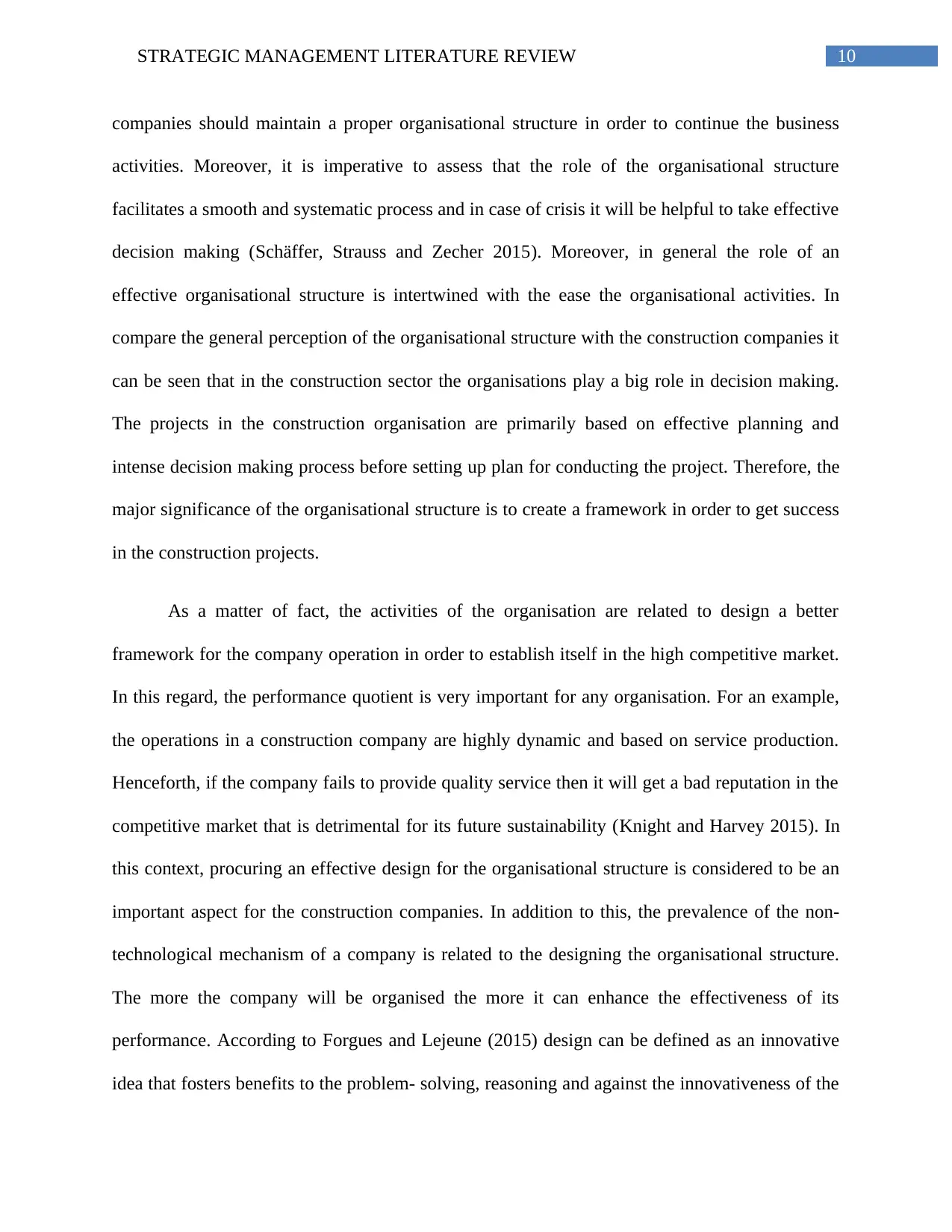
10STRATEGIC MANAGEMENT LITERATURE REVIEW
companies should maintain a proper organisational structure in order to continue the business
activities. Moreover, it is imperative to assess that the role of the organisational structure
facilitates a smooth and systematic process and in case of crisis it will be helpful to take effective
decision making (Schäffer, Strauss and Zecher 2015). Moreover, in general the role of an
effective organisational structure is intertwined with the ease the organisational activities. In
compare the general perception of the organisational structure with the construction companies it
can be seen that in the construction sector the organisations play a big role in decision making.
The projects in the construction organisation are primarily based on effective planning and
intense decision making process before setting up plan for conducting the project. Therefore, the
major significance of the organisational structure is to create a framework in order to get success
in the construction projects.
As a matter of fact, the activities of the organisation are related to design a better
framework for the company operation in order to establish itself in the high competitive market.
In this regard, the performance quotient is very important for any organisation. For an example,
the operations in a construction company are highly dynamic and based on service production.
Henceforth, if the company fails to provide quality service then it will get a bad reputation in the
competitive market that is detrimental for its future sustainability (Knight and Harvey 2015). In
this context, procuring an effective design for the organisational structure is considered to be an
important aspect for the construction companies. In addition to this, the prevalence of the non-
technological mechanism of a company is related to the designing the organisational structure.
The more the company will be organised the more it can enhance the effectiveness of its
performance. According to Forgues and Lejeune (2015) design can be defined as an innovative
idea that fosters benefits to the problem- solving, reasoning and against the innovativeness of the
companies should maintain a proper organisational structure in order to continue the business
activities. Moreover, it is imperative to assess that the role of the organisational structure
facilitates a smooth and systematic process and in case of crisis it will be helpful to take effective
decision making (Schäffer, Strauss and Zecher 2015). Moreover, in general the role of an
effective organisational structure is intertwined with the ease the organisational activities. In
compare the general perception of the organisational structure with the construction companies it
can be seen that in the construction sector the organisations play a big role in decision making.
The projects in the construction organisation are primarily based on effective planning and
intense decision making process before setting up plan for conducting the project. Therefore, the
major significance of the organisational structure is to create a framework in order to get success
in the construction projects.
As a matter of fact, the activities of the organisation are related to design a better
framework for the company operation in order to establish itself in the high competitive market.
In this regard, the performance quotient is very important for any organisation. For an example,
the operations in a construction company are highly dynamic and based on service production.
Henceforth, if the company fails to provide quality service then it will get a bad reputation in the
competitive market that is detrimental for its future sustainability (Knight and Harvey 2015). In
this context, procuring an effective design for the organisational structure is considered to be an
important aspect for the construction companies. In addition to this, the prevalence of the non-
technological mechanism of a company is related to the designing the organisational structure.
The more the company will be organised the more it can enhance the effectiveness of its
performance. According to Forgues and Lejeune (2015) design can be defined as an innovative
idea that fosters benefits to the problem- solving, reasoning and against the innovativeness of the
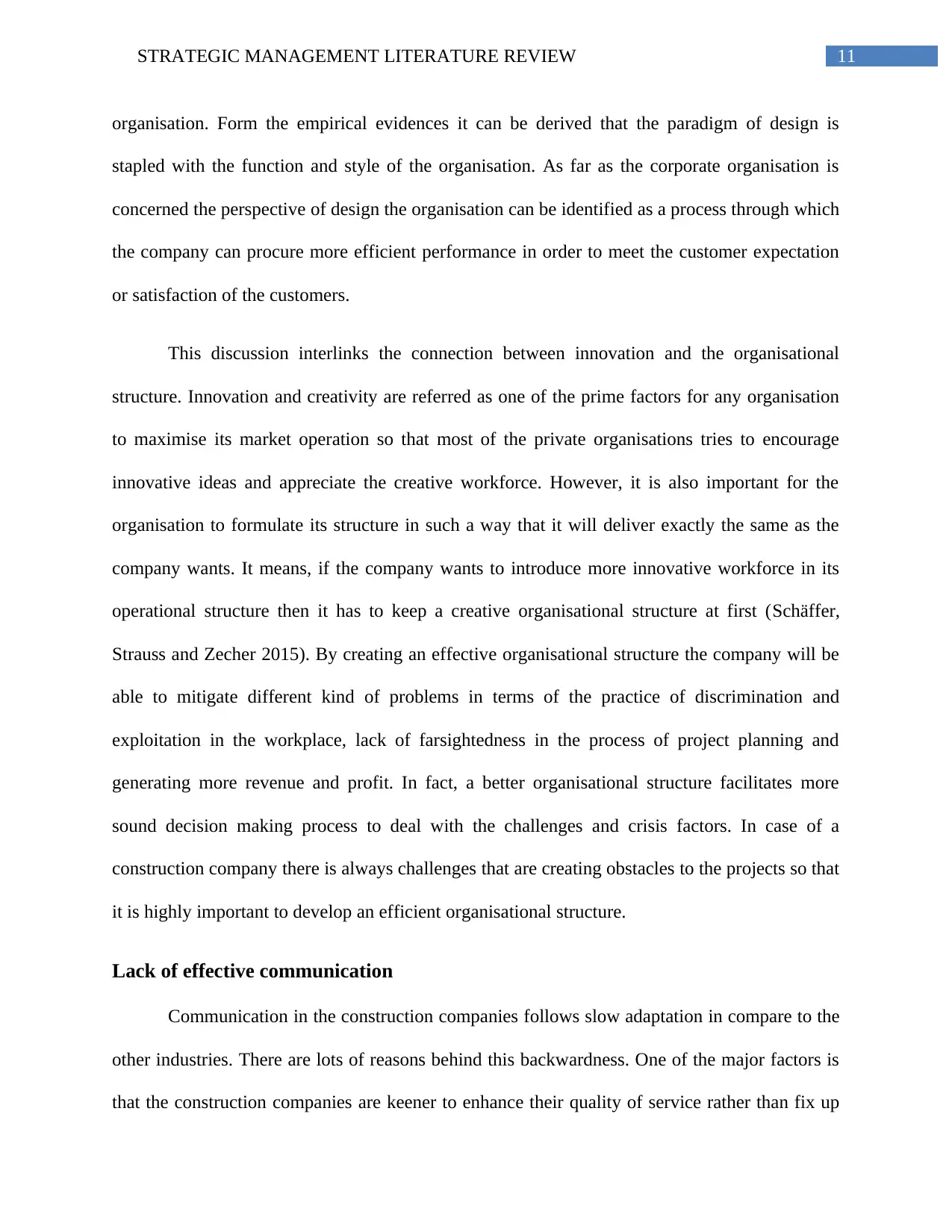
11STRATEGIC MANAGEMENT LITERATURE REVIEW
organisation. Form the empirical evidences it can be derived that the paradigm of design is
stapled with the function and style of the organisation. As far as the corporate organisation is
concerned the perspective of design the organisation can be identified as a process through which
the company can procure more efficient performance in order to meet the customer expectation
or satisfaction of the customers.
This discussion interlinks the connection between innovation and the organisational
structure. Innovation and creativity are referred as one of the prime factors for any organisation
to maximise its market operation so that most of the private organisations tries to encourage
innovative ideas and appreciate the creative workforce. However, it is also important for the
organisation to formulate its structure in such a way that it will deliver exactly the same as the
company wants. It means, if the company wants to introduce more innovative workforce in its
operational structure then it has to keep a creative organisational structure at first (Schäffer,
Strauss and Zecher 2015). By creating an effective organisational structure the company will be
able to mitigate different kind of problems in terms of the practice of discrimination and
exploitation in the workplace, lack of farsightedness in the process of project planning and
generating more revenue and profit. In fact, a better organisational structure facilitates more
sound decision making process to deal with the challenges and crisis factors. In case of a
construction company there is always challenges that are creating obstacles to the projects so that
it is highly important to develop an efficient organisational structure.
Lack of effective communication
Communication in the construction companies follows slow adaptation in compare to the
other industries. There are lots of reasons behind this backwardness. One of the major factors is
that the construction companies are keener to enhance their quality of service rather than fix up
organisation. Form the empirical evidences it can be derived that the paradigm of design is
stapled with the function and style of the organisation. As far as the corporate organisation is
concerned the perspective of design the organisation can be identified as a process through which
the company can procure more efficient performance in order to meet the customer expectation
or satisfaction of the customers.
This discussion interlinks the connection between innovation and the organisational
structure. Innovation and creativity are referred as one of the prime factors for any organisation
to maximise its market operation so that most of the private organisations tries to encourage
innovative ideas and appreciate the creative workforce. However, it is also important for the
organisation to formulate its structure in such a way that it will deliver exactly the same as the
company wants. It means, if the company wants to introduce more innovative workforce in its
operational structure then it has to keep a creative organisational structure at first (Schäffer,
Strauss and Zecher 2015). By creating an effective organisational structure the company will be
able to mitigate different kind of problems in terms of the practice of discrimination and
exploitation in the workplace, lack of farsightedness in the process of project planning and
generating more revenue and profit. In fact, a better organisational structure facilitates more
sound decision making process to deal with the challenges and crisis factors. In case of a
construction company there is always challenges that are creating obstacles to the projects so that
it is highly important to develop an efficient organisational structure.
Lack of effective communication
Communication in the construction companies follows slow adaptation in compare to the
other industries. There are lots of reasons behind this backwardness. One of the major factors is
that the construction companies are keener to enhance their quality of service rather than fix up
⊘ This is a preview!⊘
Do you want full access?
Subscribe today to unlock all pages.

Trusted by 1+ million students worldwide
1 out of 21
Related Documents
Your All-in-One AI-Powered Toolkit for Academic Success.
+13062052269
info@desklib.com
Available 24*7 on WhatsApp / Email
![[object Object]](/_next/static/media/star-bottom.7253800d.svg)
Unlock your academic potential
Copyright © 2020–2025 A2Z Services. All Rights Reserved. Developed and managed by ZUCOL.




